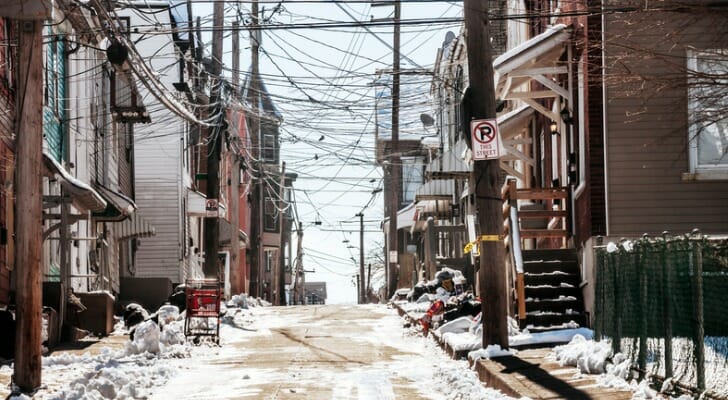The federal poverty level is a key consideration in assessing anyone’s eligibility to receive government benefits. Your access to many state and federal safety net programs is often based on where you or your household falls on the federal poverty guidelines. For example, premiums on the federal health insurance exchange are defined against this metric, as are many forms of tax relief.
Consider working with a financial advisor to improve your overall long-term financial outlook.
Federal Poverty Level Defined
Government programs typically measure households on a sliding scale of incomes against the federal poverty level. For example, a household with an income that earns 100% of the poverty level or less may receive full benefits, while one that earns 300% of the poverty level may receive fewer. Most state and federal programs cap eligibility at 400% of the federal poverty level.
When the federal government refers to “income,” it is referring to modified adjusted gross income, which is not a number on your tax return. For most people, it’s the same or similar to adjusted gross income.
A “household” is typically defined based on tax status. Two spouses filing their taxes jointly, for example, would be considered a household of two people. A parent who claims two children as her dependents would be considered a household of three. While there are some exceptions to this rule of thumb, in most cases, household size is defined by the number of people listed on a single tax form.
How and Why Poverty Levels Vary

Both state and federal governments rely on the federal poverty level, which is published by the Department of Health and Human Services (HHS). The agency defines the poverty level based on household size, increasing the cap by $5,140 for each member of the household past the first and adjusting it every year based on inflation and other factors. Poverty levels, according to the government, vary by location.
In 2025 HHS has set the federal poverty level for all contiguous 48 states, Puerto Rico, the District of Columbia and all U.S. territories, the poverty level is defined as:
Lower 48 States
- Household Size of 1: $15,650
- Household Size of 2: $21,150
- Household Size of 3: $26,650
- Household Size of 4: $32,150
- Household Size of 5: $37,650
- Household Size of 6: $43,150
- Household Size of 7: $48,650
- Household Size of 8: $54,150
For households with more than eight people, add $5,500 per additional member of the household.
Alaska
Due to the significantly different costs associated with living in Alaska, the poverty level in this state is defined as:
- Household Size of 1: $19,550
- Household Size of 2: $26,430
- Household Size of 3: $33,310
- Household Size of 4: $40,190
- Household Size of 5: $47,070
- Household Size of 6: $53,950
- Household Size of 7: $60,830
- Household Size of 8: $67,710
For households with more than eight people, add $6,880 per additional member of the household.
Hawaii
Due to the significantly different costs associated with living in Hawaii, the poverty level in this state is defined as:
- Household Size of 1: $17,990
- Household Size of 2: $24,320
- Household Size of 3: $30,650
- Household Size of 4: $36,980
- Household Size of 5: $43,310
- Household Size of 6: $49,640
- Household Size of 7: $55,970
- Household Size of 8: $62,300
For households with more than eight people, add $6,330 per additional member of the household.
Limitations of the Federal Poverty Level
Costs of living vary widely not just from state to state but, far more importantly, between urban and rural areas. For example, a Michigan resident living in the college and technology town of Ann Arbor will have costs of living comparable to that of Chicago or even Boston. Another resident of the same state living in its rural Upper Peninsula will pay a fraction of that. The federal poverty level does not account for that.
While the government does publish different poverty levels for Hawaii and Alaska, this is otherwise a blunt instrument. When government programs calculate benefits and tax credits, they cannot allow for the fact that a family earning 200% of the federal poverty level can live in upstate New York but will barely survive in Manhattan.
Bottom Line

The federal poverty level is a key metric for anyone seeking to benefit from state or federal safety net programs. The actual level is set by the Department of Health and Human Services, and it varies depending on the state you live in. It is subject to change yearly. When making personal finance decisions, it’s best to treat the numbers as a guide simply because there are so many variations in the cost of living within every state.
Personal Finance Tips
- A financial advisor can show you ways to raise your net worth and use the resources you currently have – or benefits you qualify for – more effectively. Finding a financial advisor doesn’t have to be hard. SmartAsset’s free tool matches you with vetted financial advisors who serve your area, and you can have a free introductory call with your advisor matches to decide which one you feel is right for you. If you’re ready to find an advisor who can help you achieve your financial goals, get started now.
- When taking into account social safety net programs and tax credits, the U.S. has managed to decrease poverty significantly from the mid-20th to the early 21st century. That is, until the onset of COVID-19. As businesses have foundered and the economy has slowed dramatically, many U.S. households have fallen under the federal poverty line.
Photo credit: ©iStock.com/eric1513, ©iStock.com/peeterv, ©iStock.com/kuarmungadd
